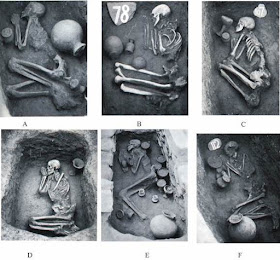In Bulgaria, a special loaf of bread was made immediately after a person died, during the washing of the body. It was a simple round loaf, sometimes with a cross. In northeastern Bulgaria it was baked from dough which was made with the water used to bathe the deceased...
Sources:
"Glasnik Etnografskog muzeja u Beogradu knjiga 19 godina 1956"
"Bread in the folk culture of the Serbs in its pan Slavic context"
The dough for the bread was kneaded in a wooden throw. Before the kneading of the bread started, a candle was lit and put next to the through. And the dough was kneaded until the candle burned out...
In some parts of Bulgaria, this bread had to be made by a "clean" woman who had no sexual intercourses, either a virgin girl, a widow or a grandmother...
The name of this bread was пътнина (patnina), meaning "(bread for the) journey". In some parts of Bulgaria, this bread was placed in the coffin with a bottle of water and a bottle of wine, so the deceased would have enough food and drink for his journey to the other world...
This is very interesting. Remember my articles about the pots and pans found in Neolithic, Bronze and Iron Age graves all over the world. Like these Ghandara culture graves from Pakistan, dated to 1200-800BC...Were the drinking vessels placed in graves with drink "for the other world"...
I talked about this in my post "One for the road"...Why would the living bother with making sure the dead had enough food and drink in the otherworld?
I talked about this in my posts "Thirst", "White feast", "Soul breads". I talked about the link between the dead and rain and grain fertility in Roman mythology in my post "Lapis Manalis"....
Also, remember this?
"...humiliation of the Hittite kingdom is the result of the fact that the Hittites have forgotten to respect the sacred bond with their dead..." - Last Hittite king Suppiluliuma II. From my post "House of bones"...
This is why people not just buried their dead with food and water, but also regularly feasted with the dead.
Starting from the funeral feast.
In some other parts of Bulgaria, the bread was, while still warm, broken over the deceased person's head, making sure that steam, representing the deceased person's soul, rose the broken bread...The bread was then ritually eaten by the people attending the bathing of the body...
BTW, in Herodotus 4:73 we read that when a Scythian man died his family would put the body on a cart and take it to all his friends houses. They would bring the body into each house where they would eat and drink together with the corpse...





No comments:
Post a Comment